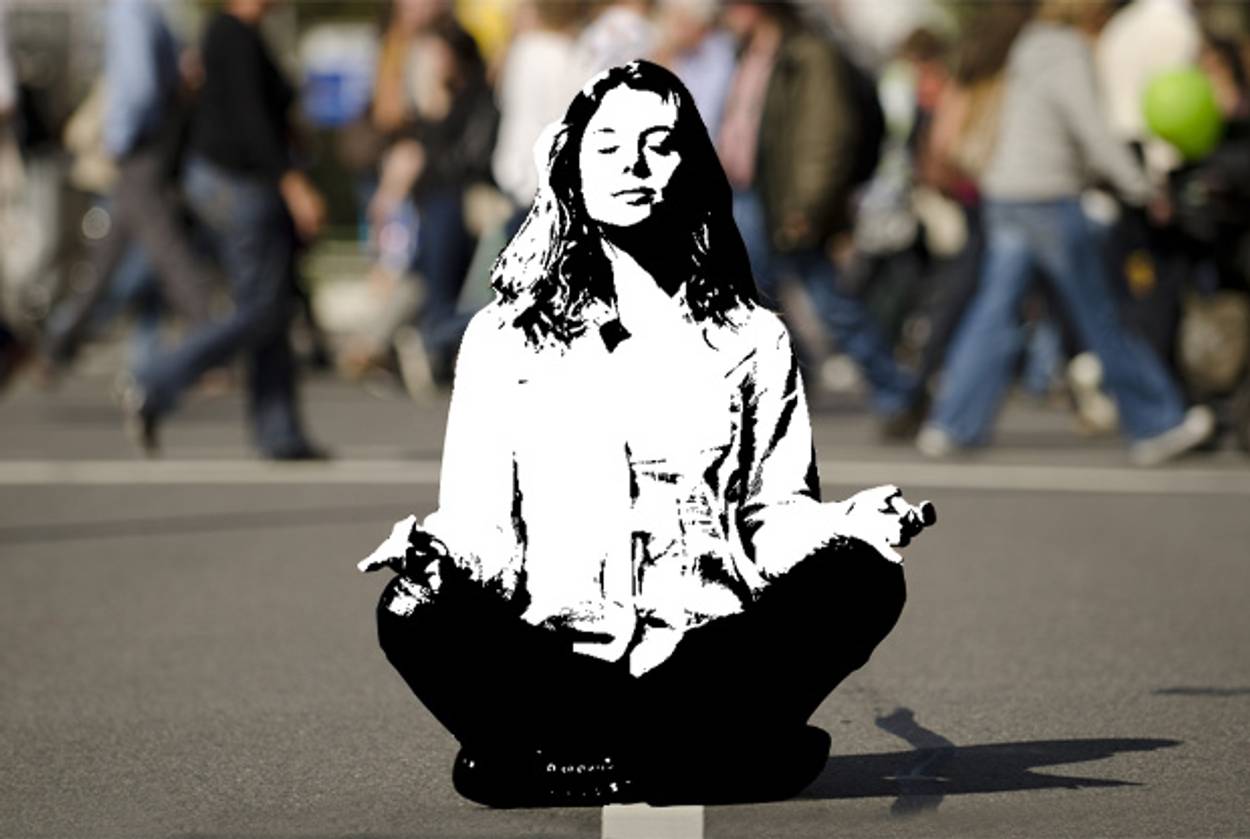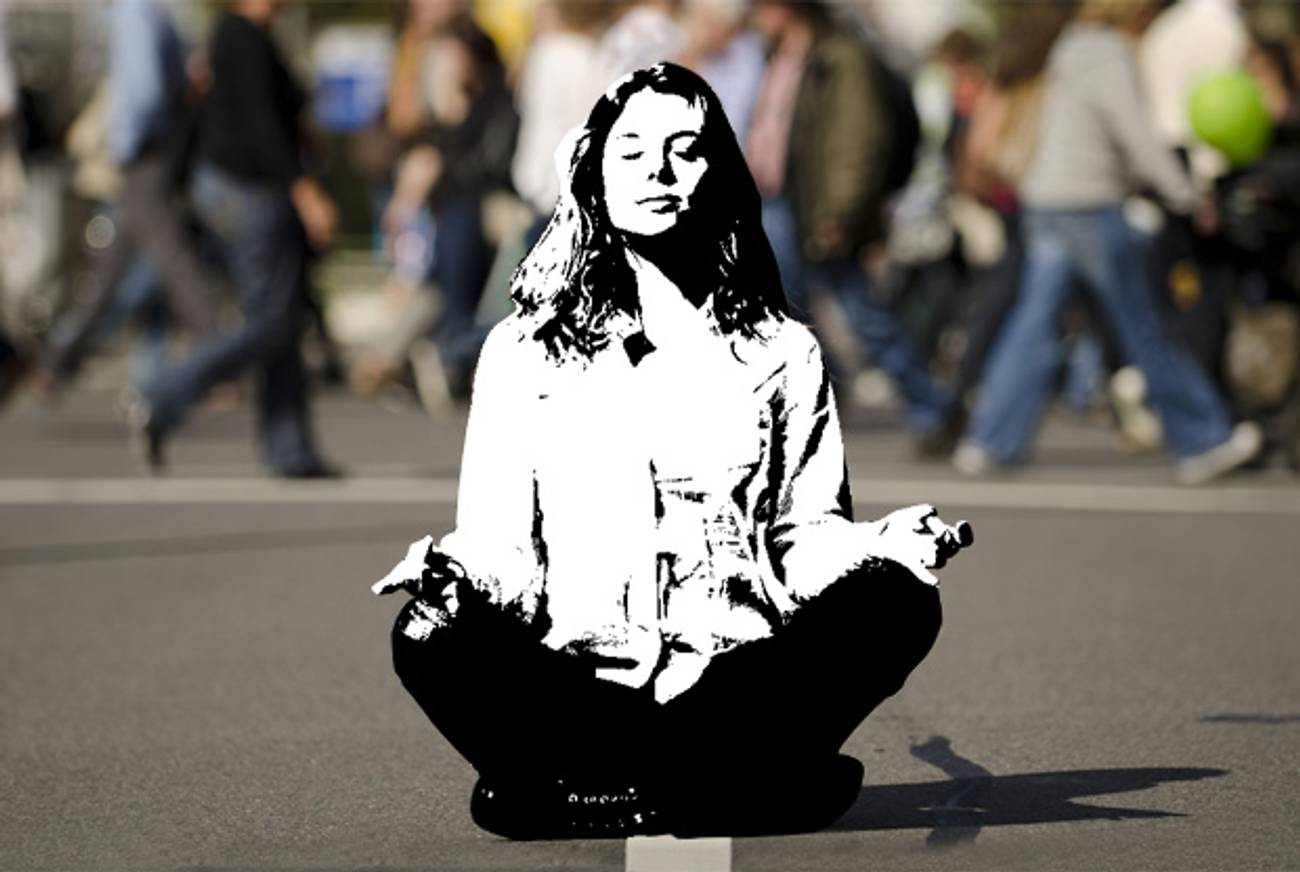A Jew Talks Sit
How meditation helped me unplug from my chaotic life and connect with Judaism




My cousin and I are both perpetually busy people: I’ve been known to zip between three or four cultural events in a single day, my bike piled high with gear, while she can carry on several simultaneous cell-phone conversations while driving. So, when she suggested, five years ago, that I try meditation, I was puzzled. She said it had helped her to gain perspective and establish boundaries, even setting times when her cell phone was off-limits. But I didn’t see how it could help me. Sitting in one place did not seem like a way to get anywhere—I mean, who had time? And besides, meditation certainly didn’t seem Jewish.
But that all changed over the last six months. Now I sit and meditate on my fire escape each morning. The daily practice of meditation has helped me take a break from the computer screen and separate, at least a tiny bit, from the need to respond to everything at the speed of text. But even more unexpectedly, it’s introduced me to a Jewish community that I want to return to on a regular basis.
***
For years after that first conversation with my cousin, I stuck to my skepticism. “Om Shanti” mantras in yogic meditation put me on the defensive as a Jew: No matter how soft or subtle the chanting, no matter how soulful or soothing the syllables, I remained convinced they were chords of conversion.
Then I heard about the Jewish Meditation Center of Brooklyn, which billed itself as a “community of meditators and spiritual leaders transforming the world through the cultivation of awareness, compassion, and Jewish wisdom.” I was intrigued, but still suspicious. Why should a mostly secular, jeans-wearing Jewish person join a group of Bu-Jews in orange robes? It took me another year to go to the center, to see for myself.
I attended a monthly beginners’ night last November. There were 10 of us, enough for a minyan, including regulars and first-timers like me, in the second-floor music room of the Hannah Senesh Community Day School. No one was wearing a robe; actually, I was the only one in orange, a well-worn cardigan missing the third button from the top.
Jewish meditation is linked to mysticism, I learned, an ancient Hebraic practice found in kabbalah. For instance, the Amidah part of the synagogue service is often considered an opportunity for silent prayer or meditation, and another form of Jewish meditation, hitbodedut (self-seclusion), involves going off on one’s own to address the Almighty in one’s own words. So, meditation wasn’t necessarily foreign to Judaism after all.
We learned some short meditations that first night, focusing on breath, hearing, and specific parts of the body. Those lasted two minutes, then five, which marked the edge of my comfort zone. But sitting in silence with other people was surprisingly relaxing. The “sit leader” for that session gave friendly instructions and made it clear that there was no single right way to go about meditation. Afterward, she led us to a local watering hole to celebrate a simcha: One of the participants had passed the bar exam. Instant camaraderie.
She also invited us to return for regular weekly sits: two sessions of 20 minutes preceded by a kavannah (intention) based on the weekly Torah portion, with time for sharing verbal reflections between the silences. A room of Jews sitting without talking for 20 minutes seemed unlikely—and almost cruel. But curiosity and determination lured me back. I was eager to develop a weekly routine and liked the idea of getting to know like-minded people by sharing space rather than small talk. Now that I realized that meditation was safe turf for Jewish learning, I was willing to engage.
At my first full-length session, I perched on a black zafu, or meditation cushion. My fellow meditators—again a mix of beginners and veteran practitioners—sat quietly. But after such a promising introductory session, this sit felt interminable. I wanted to leave. My body felt inert; I did not understand how to “follow” or “work with” the breath. My breathing hung like an invisible habit. A different sit leader—volunteers take turns running sessions—suggested several techniques to maintain focus. One idea was to count breaths on the exhale. That sounded reasonable enough, but I had trouble distinguishing the inhale from the exhale. In other words, I was taking my breath for granted.
As a kid, I experienced similar confusion with my right and left and, as a result, learned to do a cartwheel leading with my normally nondominant left hand. It proved to be a good party trick for the 10-year-old set. But if I messed up in meditation, it might be more than a party trick. It might change my entire mindset.
But wasn’t that the point?
I kept going back. Meditation made me examine my habits and helped me identify my patterns of thinking and understand the possibility of tweaking my responses. Meditation invited me to be gentle with myself. Particularly helpful with this was chesed meditation, a series of blessings—for community, others, and self—that originates with the Jewish concept of chesed, or loving kindness.
Unlike in synagogue services, there was no set liturgy, no language to mispronounce, no melody to carry (or drop). Yet we were engaged in a collective Jewish practice, reflecting on the weekly Torah portion as a community.
By now, I have become a regular at the center, which means I continue to sit with newcomers newer than me and with familiar faces-turned-friends. Sitting still remains relatively new for me. And I’m not the only one who finds it challenging. Meditators of all experience levels share feedback that mirrors my past and present responses:
“I think I overthink breathing.”
“That was hard.”
“My mind kept wandering.”
It’s hard to pinpoint exactly how my burgeoning meditation practice has made a difference in my day-to-day life. I may be a bit calmer or slightly slower to anger. I’m beginning to understand that I don’t have to act on every idea or urge or impulse, at least not immediately. But mostly, I go back for the people— to sit still, to breathe, and share with others.
It’s not always the fully fledged, grounded feeling my cousin predicted, but in a way, it’s better: The community is committed to collective and individual grappling, with the intention to have our practice radiate out into the world. This sounded a bit hokey to me at the beginning, but I do feel like we are forging new, positive pathways of interaction, internally and externally.
And the Jewish Meditation Center isn’t the only place where I meditate. Just as people daven alone at home, in addition to going to a minyan at synagogue, a person can also meditate solo, independent of the larger group. Mornings, I sit cross-legged on my wrought iron, fifth-floor fire escape (or if it’s raining, next to the window) for 10 minutes. Sometimes 11.
Still, resistance and bargaining figure in. Here’s a peek at my inner dialogue on a typical morning:
Ten minutes? Ten whole minutes? Again?
It’s only 10 minutes. Not even a full quarter-hour.
You don’t have time.
I just wasted 20 minutes staying in bed.
See? You can’t afford to take 10 minutes out of your day.
I can’t afford not to.
OK, fine. Just not right now.
If not now, when?
So, when I head to the fire escape, it’s not an act of flight, but a gesture of commitment. Just getting in position can be akin to scaling a major peak. (My fire escape is above the Brooklyn tree line.) I take in the sounds of birds, take note of my thoughts, and take turns blessing friends, family, strangers, and myself with the chesed meditation.
May you be blessed with peace.
May you be blessed with joy.
May you be blessed with lovingkindness.
May you be blessed with compassion.
I still have trouble distinguishing between the in breath and the out. It’s still hard to maintain a modicum of calm amid ambulance sirens, daily worry, and impending deadlines. But I always get something out of sitting: the understanding that, resistance aside (or rather, fully present), I have the ability to set—and fulfill—a daily commandment.
***
Like this article? Sign up for our Daily Digest to get Tablet Magazine’s new content in your inbox each morning.
Laura Silver is a writer-in-residence at the New York Public Library’s Wertheim Study and the author of Knish: In Search of the Jewish Soul Food, due out from Brandeis University Press in May 2014.
Laura Silver is a writer-in-residence at the New York Public Library’s Wertheim Study and the author ofKnish: In Search of the Jewish Soul Food, due out from Brandeis University Press in May 2014.